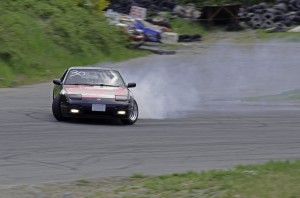Dan Cormier is emphatic that Capital City Drift is more than a racing series. It’s a community.
A pair of strangers approached the former Camosun student in a Tim Horton’s parking lot a couple years ago after noticing his customized Nissan 200sx with swapped-in Skyline engine. They invited him to a drift event the next day. From then on, he was hooked.

Two years later and Cormier is a core member of the drifting scene. He’s still driving the 200sx, although it’s seen its share of accidents and is now known as “the crab” due to its bent suspension and propensity to travel sideways.
Fortunately for Cormier, traveling sideways isn’t the disadvantage it would be in, say, drag racing. Event organizer Serge Drouin, an engineering bridge program student at Interurban, describes drifting as “basically doing a burnout sideways as fast as you can.”
“There’s smoke everywhere, you’re getting really close to the other cars, everyone is having a good time,” he says.
According to Cormier, two main types of people are drawn to drifting: techies who enjoy swapping engines and tweaking suspensions, and extreme-sports enthusiasts who started out skateboarding and BMXing, but can now afford to thrash automobiles like they used to thrash boards and bikes.
When it comes to building a drift car on a budget, aesthetics are low on the list of priorities. The vehicles at Western Speedway on drift day look nothing like the shiny, pimped-out specimens from The Fast and the Furious: Tokyo Drift.
Most of the cars are Nissan 240s and Toyota Corollas with mismatched quarter panels held on with zip ties. It’s a utilitarian culture, where the goal is to get out and drift. In most cases, an immaculate paint job would be a short-lived waste of time.
“Crashing is fairly common, but no one has ever gotten hurt drifting at Western Speedway,” says Drouin.
He attributes this to the small size of the track and the relatively low speeds involved. By the time a collision occurs, the car has usually slowed to less than 30 kilometres an hour.
Acacia Spencer-Hills, a volunteer, sees Capital City Drift as a valuable outlet for drifters and also sees it as an important part of keeping illegal racing off the streets and on the tracks.
“Where else can you get that experience of just fucking around in your car,” says Spencer-Hills, “and not getting in trouble with the cops?”
Capital City Drift Hallowe’en practice
9am-6pm, October 16
Western Speedway
Drivers $70, spectators free
capitaldrift.ca

